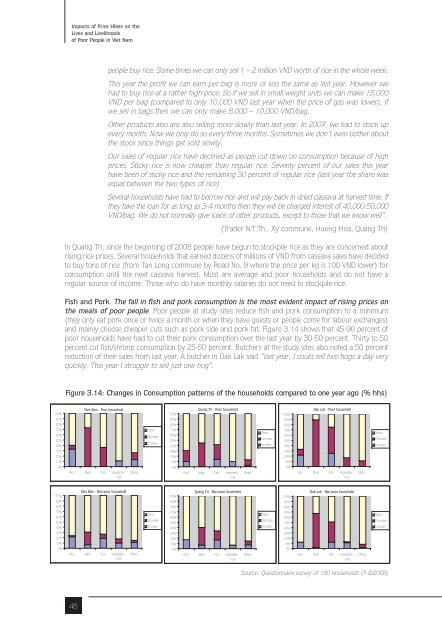Untitled - Oxfam Blogs
Untitled - Oxfam Blogs
Untitled - Oxfam Blogs
You also want an ePaper? Increase the reach of your titles
YUMPU automatically turns print PDFs into web optimized ePapers that Google loves.
Impacts of Price Hikes on the<br />
Lives and Livelihoods<br />
of Poor People in Viet Nam<br />
people buy rice. Some times we can only sell 1 – 2 million VND worth of rice in the whole week.<br />
This year the profit we can earn per bag is more or less the same as last year. However we<br />
had to buy rice at a rather high price. So if we sell in small weight units we can make 15,000<br />
VND per bag (compared to only 10,000 VND last year when the price of gas was lower). If<br />
we sell in bags then we can only make 8,000 – 10,000 VND/bag.<br />
Other products also are also selling more slowly than last year. In 2007, we had to stock up<br />
every month. Now we only do so every three months. Sometimes we don’t even bother about<br />
the stock since things get sold slowly.<br />
Our sales of regular rice have declined as people cut down on consumption because of high<br />
prices. Sticky rice is now cheaper than regular rice. Seventy percent of our sales this year<br />
have been of sticky rice and the remaining 30 percent of regular rice (last year the share was<br />
equal between the two types of rice)<br />
Several households have had to borrow rice and will pay back in dried cassava at harvest time. If<br />
they take the loan for as long as 3-4 months then they will be charged interest of 40,000-50,000<br />
VND/bag. We do not normally give loans of other products, except to those that we know well”.<br />
(Trader N.T.Th., Xy commune, Huong Hoa, Quang Tri)<br />
In Quang Tri, since the beginning of 2008 people have begun to stockpile rice as they are concerned about<br />
rising rice prices. Several households that earned dozens of millions of VND from cassava sales have decided<br />
to buy tons of rice (from Tan Long commune by Road No. 9 where the price per kg is 100 VND lower) for<br />
consumption until the next cassava harvest. Most are average and poor households and do not have a<br />
regular source of income. Those who do have monthly salaries do not need to stockpile rice.<br />
Fish and Pork. The fall in fish and pork consumption is the most evident impact of rising prices on<br />
the meals of poor people. Poor people at study sites reduce fish and pork consumption to a minimum<br />
(they only eat pork once or twice a month or when they have guests or people come for labour exchanges)<br />
and mainly choose cheaper cuts such as pork side and pork fat. Figure 3.14 shows that 45-90 percent of<br />
poor households have had to cut their pork consumption over the last year by 30-50 percent. Thirty to 50<br />
percent cut fish/shrimp consumption by 25-50 percent. Butchers at the study sites also noted a 50 percent<br />
reduction of their sales from last year. A butcher in Dak Lak said “last year, I could sell two hogs a day very<br />
quickly. This year I struggle to sell just one hog“.<br />
Figure 3.14: Changes in Consumption patterns of the households compared to one year ago (% hhs)<br />
100%<br />
90%<br />
80%<br />
70%<br />
60%<br />
50%<br />
40%<br />
30%<br />
20%<br />
10%<br />
0%<br />
Dien Bien - Poor household<br />
Rice Meat Fish Vegetable,<br />
fruit<br />
Others<br />
Same<br />
Decrease<br />
Increase<br />
100%<br />
90%<br />
80%<br />
70%<br />
60%<br />
50%<br />
40%<br />
30%<br />
20%<br />
10%<br />
0%<br />
Quang Tri - Poor household<br />
Rice Meat Fish Vegetable,<br />
fruit<br />
Others<br />
Same<br />
Decrease<br />
Increase<br />
100%<br />
90%<br />
80%<br />
70%<br />
60%<br />
50%<br />
40%<br />
30%<br />
20%<br />
10%<br />
0%<br />
Dak Lak - Poor household<br />
Rice Meat Fish Vegetable,<br />
fruit<br />
Others<br />
Same<br />
Decrease<br />
Increase<br />
100%<br />
90%<br />
80%<br />
70%<br />
60%<br />
50%<br />
40%<br />
30%<br />
20%<br />
10%<br />
0%<br />
Dien Bien - Non-poor household<br />
Rice Meat Fish Vegetable,<br />
fruit<br />
Others<br />
Same<br />
Decrease<br />
Increase<br />
100%<br />
90%<br />
80%<br />
70%<br />
60%<br />
50%<br />
40%<br />
30%<br />
20%<br />
10%<br />
0%<br />
Quang Tri - Non-poor household<br />
Rice Meat Fish Vegetable,<br />
fruit<br />
Others<br />
Same<br />
Decrease<br />
Increase<br />
100%<br />
90%<br />
80%<br />
70%<br />
60%<br />
50%<br />
40%<br />
30%<br />
20%<br />
10%<br />
0%<br />
Dak Lak - Non-poor household<br />
Rice Meat Fish Vegetable,<br />
fruit<br />
Others<br />
Same<br />
Decrease<br />
Increase<br />
Source: Questionnaire survey of 180 households (7-8/2008)<br />
48

















